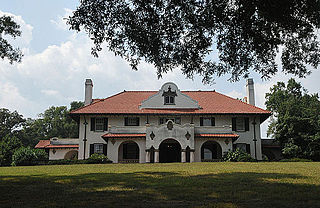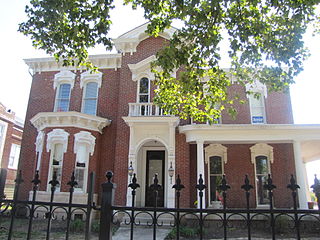Purcell & Elmslie (P&E), as it was most widely known, was a progressive American architectural practice. P&E was the second most commissioned firm of the Prairie School, after Frank Lloyd Wright. The firm was active from 1917 to 1921.

Kenmore, also known as Kenmore Plantation, is a plantation house at 1201 Washington Avenue in Fredericksburg, Virginia. Built in the 1770s, it was the home of Fielding and Betty Washington Lewis and is the only surviving structure from the 1,300-acre (530 ha) Kenmore plantation.

The Playmakers Theatre, originally Smith Hall, is a historic academic building on the campus of the University of North Carolina at Chapel Hill. Built in 1850, it was designated a National Historic Landmark for its architecture, as an important example of Greek Revival architecture by Alexander Jackson Davis. It is now a secondary venue of the performing company, which is principally located at the Paul Green Theatre.

Chestertown Historic District is a historic district in Chestertown, Maryland. It was listed on the National Register of Historic Places and designated a National Historic Landmark in 1970, and its area was increased in 1984. The town on the Chester River, became the chief port for tobacco and wheat on the Eastern Shore of Maryland between 1750 and 1790. The port declined thereafter, as Baltimore became the major port for such activity. In consequence, Chestertown acquired a collection of more than fifty Georgian style town houses. The 18th-century residential area survived without harm a 1910 fire that destroyed the central business district of Chestertown.

Linden is a historic home located near Port Tobacco, Charles County, Maryland, United States. It is a rambling frame house, consisting of a 2 1⁄2-story main block with wings, embodying many traditional characteristics of Tidewater architecture. The house is situated on the crest of a hill overlooking the Port Tobacco Valley. The home was begun early in the 1780s and enlarged about 1800, and in the late 1830s. Linden was probably built as a summer residence about 1783, by Henry Barnes, a wealthy Port Tobacco merchant and on a property that remained in the same family for over 300 years.

Stagg Hall, is a historic home located at Port Tobacco, Charles County, Maryland, United States. It is a two-story frame house built about 1766 adjacent to Port Tobacco's former town square. It was built by Thomas Howe Ridgate, a prosperous Port Tobacco merchant.

Seclusaval and Windsor Spring is a historic property in Richmond County, Georgia that includes a Greek Revival building built in 1843.

The Benjamin N. Duke House, also called the Duke–Semans Mansion and the Benjamin N. and Sarah Duke House, is a landmarked mansion located at 1009 Fifth Avenue at East 82nd Street in the Upper East Side of Manhattan, New York City. It was built in 1899-1901 and was designed by the firm of Welch, Smith & Provot in the Beaux-Arts style.

The Henry H. Smith/J.H. Murphy House is a historic building located on the east side of Davenport, Iowa, United States. It was listed on the National Register of Historic Places in 1983. In 1997 it was listed on the Davenport Register of Historic Properties as the Octagon House.

The Nicholas J. Kuhnen House is a historic building located in central Davenport, Iowa, United States. It has been listed on the National Register of Historic Places since 1983.

The John Sprunt Hill House is a historic house at 900 S. Duke street in Durham, North Carolina, in the Morehead Hill Historic District. Built in 1911–1912, it was the home of John Sprunt Hill (1869–1961) and his wife Annie Watts Hill, daughter of George Washington Watts, co-founder of the American Tobacco Company. It was listed on the National Register of Historic Places in 1978.

David H. Miller Tobacco Warehouse is a historic tobacco warehouse located at Lancaster, Lancaster County, Pennsylvania. It was built in 1900, and is a three-story, rectangular red brick building on a stone foundation. It is six bays by nine bays and has a slightly pitched gable roof. It housed local tobacco companies until occupied by the Lorillard Tobacco Company after 1938.

The Rinckel Mansion, at 102 N. Curry St. in Carson City, Nevada, is a historic house built in 1872. It was home of Mathias Rinckel, a merchant in Carson City. It was designed and built by Ecole de Beaux Arts-trained architect Charles H. Jones.

W. F. Smith and Sons Leaf House and Brown Brothers Company Building, also known as Piedmont Leaf Tobacco Co., is a historic tobacco manufacturing complex located at Winston-Salem, Forsyth County, North Carolina. The complex includes two buildings. The W. F. Smith and Sons Leaf House was built about 1890, and is a 4 1/2-story, nine bays long and three bays wide, stuccoed brick building with a stepped gable facade. The former Brown Brothers building, was built between 1890 and 1895, and is a five-story brick building with a mansard roof and hip roof dormer windows. By 1900 both buildings housed tobacco prizeries.

The Davis-Hull House is a historic house located at 1004 North Main Street in Carthage, Tennessee. It was listed on the National Register of Historic Places on January 4, 1983.

Russell House is a historic mansion in Springfield, Tennessee, USA. It was designed in the Colonial Revival architectural style. It was listed on the National Register of Historic Places on November 22, 2011.

The Smith–Johnson House, also known as The Old Brick, is a historic residence located in Oskaloosa, Iowa, United States. It was built for William T. Smith in 1853, the same year he was elected as the first mayor of Oskaloosa. A lawyer, Smith was a native of Pennsylvania who settled in the town in 1848 and became county attorney the same year. In addition to his political and legal responsibilities he founded the first bank in town, and he was involved with other profitable financial ventures. He lived in the house until 1865 when Abijah Johnson, a Quaker merchant who moved to Oskaloosa to be a part of the flourishing Quaker communities here and in the surrounding areas. His son J. Kelly Johnson, an attorney who served in the Iowa Senate, took over the house after his father's death in 1894.

The Charles Berryhill House is a historic house located at 414 Brown Street in Iowa City, Iowa.

The William Harvey House is a historic house at 1173 Windor Avenue in Windsor, Connecticut. Built in 1868, it is a good local example of Italianate architecture, executed in brick. It was listed on the National Register of Historic Places in 1988.

The Northington-Beach House is a historic mansion in Clarksville, Tennessee, U.S.. It was built in 1886 for Michael C. Northington, a tobacco merchant who served as the mayor or Clarskville from 1906 to 1910. In 1925, it was purchased by Oscar Beach, the founder of the Pan-American Oil Company.



















